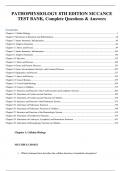Exam (elaborations)
PATHOPHYSIOLOGY 8TH EDITION MCCANCE TEST BANK, Complete Questions & Answers
- Course
- Institution
- Book
Chapter 11: Stress and Disease MULTIPLE CHOICE 1. Exhaustion occurs if stress continues when which stage of the general adaptation syndrome is not successful? a. Flight or fight c. Adaptation b. Alarm d. Arousal ANS: C Exhaustion occurs if stress continues and adaptation is not successful, u...
[Show more]



